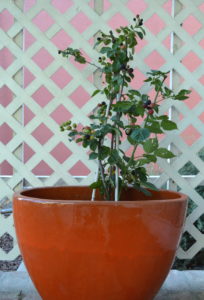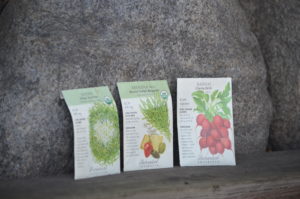Growing Vegetables Year Round
 If you enjoy harvesting fresh vegetables from your summer garden, here’s some good news: You can keep the bounty going all year long! In most parts of California, the climate is moderate enough to plant edibles in the cool season as well as in the warm months, and in the parts of the state where winters are cold and frosty, there are still tricks for extending the growing season.
If you enjoy harvesting fresh vegetables from your summer garden, here’s some good news: You can keep the bounty going all year long! In most parts of California, the climate is moderate enough to plant edibles in the cool season as well as in the warm months, and in the parts of the state where winters are cold and frosty, there are still tricks for extending the growing season.
Crops to Plant for the Warm Season (April – September)
Summer edibles can be planted outside as early as March or April or as late as May or June, depending primarily on when you are past the danger of frost and when nighttime temperatures climb above 50°F. Harvests typically end in September or October (again, depending on early frost dates and nighttime temperatures) but may be extended and overlap with cool-season planting. Here’s what you can plant for the warm months:
- Beans*
- Beets
- Blackberries (perennial)
- Broccoli
- Carrots
- Cauliflower
- Cucumbers*
- Kohlrabi
- Lettuce
- Peas
- Potatoes
- Radishes
- Raspberries (perennial)
- Rhubarb (perennial)
- Spinach
- Squash*
- Strawberries (perennial)
- Sweet potatoes**
- Swiss chard
- Tomatoes*
*When night-time temperatures are above 50 degrees.
**When soil temperature has reached 70 degrees.
Crops to Plant for the Cool Season (October Through March)
As warm-season crops finish their harvest in early fall, you can start planting these cool-season crops. Avoid planting heat-sensitive crops like spinach or lettuce until your region is no longer experiencing high summer-like temperatures. But you can plant most cool-season crops from early fall until frosts arrive and then plant again after the danger of frost has passed. Kale is one plant that can tolerate frost (or even snow) and may taste sweeter after the cold weather sets in. And in areas where the ground doesn’t freeze and drainage is good, carrots can be kept in the ground through winter and harvested as needed.
- Artichoke (perennial)
- Asparagus (perennial)
- Fava bean
- Beets
- Blackberries (bare-root, perennial)*

- Blueberries (perennial)
- Broccoli
- Brussels sprouts
- Carrot
- Cauliflower
- Chinese cabbage
- Citrus (perennial)**
- Collards
- Deciduous fruit trees (bare-root, perennial)
- Garlic
- Kale
- Kiwi (perennial)
- Kohlrabi
- Lettuce
- Mustard
- Onion (bulb)
- Parsnip
- Pea
- Pineapple guava (perennial)**
- Potatoes
- Radish
- Raspberries (bare-root, perennial)*
- Shallot
- Spinach
- Strawberries (perennial)
- Swiss chard
- Turnip
* In warmer parts of the state
** In frost-free areas
Tips for Extending the Growing Season
To make the most of your all-season edible garden, try using some of these tips to stretch out your harvests:
- Make a Plan. The best way to map out a year-round edible garden is to plan what you’d like to harvest each month and then work backwards to figure out how much and when you need to plant.

- Plant Successively. Sow rounds of seeds or plant seedlings repeatedly every two or three weeks. As the earliest plantings are dying off, the later plantings will be ready for harvest. See Planting Seeds Successfully.
- Choose Varieties to Prolong the Harvest. If you grow early, mid, and late-season varieties of the same crop, you’ll have fresh fruits or vegetables a lot longer than if you plant all one variety.
- Keep Your Soil Healthy. Year-round growing can deplete soil of nutrients. Keep adding compost throughout the year and rotate crops to keep it nutrient-rich. Check out Compost in Your Garden for more information.
- Make Use of Your Whole Garden. Look for places that present planting opportunities as the seasons change. A too-shady area under a deciduous tree may get enough light in the fall and winter after leaves have fallen. Learn more about Growing Vegetables in Shade and the Microclimates in Your Garden!
- Plant in Mobile Containers. Container planting gives you the ability to move your crops around to make the most of the changing light. Soil in containers also heats up more quickly in the spring than ground soil, which can lead to earlier harvests.
- Be Prepared for Frost. Frost blankets or cold frames can protect plants and keep your harvest going even after frosts begin.
- Grow Annual and Perennial Crops. With perennial crops like strawberries, asparagus or blueberries, you get harvests year after year from just one planting. Annual crops, however, provide variety and the chance to experiment with new hybrids. Plan annual crops to fill in between your tried-and-true perennial crops.
For best success, start small. Pick one or two fruits or vegetables you’d like to harvest each season and grow your garden from there. You’ll find our California climate makes year-round edible gardening both worthwhile and fun!